ASRock B650 Pro RS ATX AM5 Motherboard Review
One of the big things that we’re supposed to remember about PCIe 5.0 is that it’s expensive, and not because companies are overcharging for the controllers, but because onboard devices such as switches and redrivers are pricey at that spec. Heck, they were already pricey at PCIe 4.0. PCIe 3.0 is the only thing a budget buyer can get, or is it?
| ASRock B650 Pro RS | |||
| Socket | AM5 | Form Factor | ATX |
| Chipset | AMD B650 | Voltage Regulator | 17 (14+2+1) Phases |
| Rear I/O | |||
| Video Ports | DisplayPort 1.4 (4k/120Hz Max), HDMI 2.1 (4k/120Hz Max) | Audio Jacks | (3) Analog |
| Rear USB 3.x | (1) 10Gb/s Type-C, (1) 10Gb/s Type A, (2) 5Gb/s Type A | Legacy Ports/Jacks | (6) USB 2.0 |
| Network Jacks | (1) 2.5GbE | I/O Panel Extras | USB BIOS Flashback Button |
| Internal Interface | |||
| PCIe x16 | (1) v4.0 x16, (1) v3.0 x4 | SATA Ports | (4) 6Gb/s |
| PCIe x8 | ✗ | USB Headers | (1) v3.x Gen2x2 (20Gb/s), (1) v3.x Gen1, (1.5) v2.0 |
| PCIe x4 | ✗ | Fan Headers | (6) 4-Pin |
| PCIe x1 | (1) v4.0 (open end) | Legacy Interfaces | UART (3-pin), System (Beep-code) Speaker |
| CrossFire/SLI | 2 / ✗ | Other Interfaces | FP-Audio, Thunderbolt AIC, RGB LED, (3) ARGB LED, TPM |
| DIMM slots | (4) DDR5 | Diagnostics Panel | ✗ |
| M.2 slots | (1) PCIe 5.0, (1) PCIe 4.0 x4, (1) PCIe 3.0 x2, (1) Key-E | Internal Button/Switch | ✗ / ✗ |
| Controllers | |||
| SATA Controllers | Integrated, ASM1061 (0/1) | USB Controllers | (2) ASM1543 4-to-1 CH Gen1 to Gen2, ASM1074 Hub |
| Ethernet Controllers | RTL8125BG 2.5Gb/s PCIe | HD Audio Codec | ALC897 |
| Wi-Fi / Bluetooth | ✗ | DDL/DTS Connect | ✗ |
Get it at Amazon

(click for availability)
ASRock isn’t exactly giving anything away here, as the only PCIe 5.0 interface on the B650 Pro RS is its four-lane NVMe storage slot. That saves the company a bunch of production cost, as we scanned the board until our eyes dried out and the only redrivers found were for USB. And even those were in short supply.
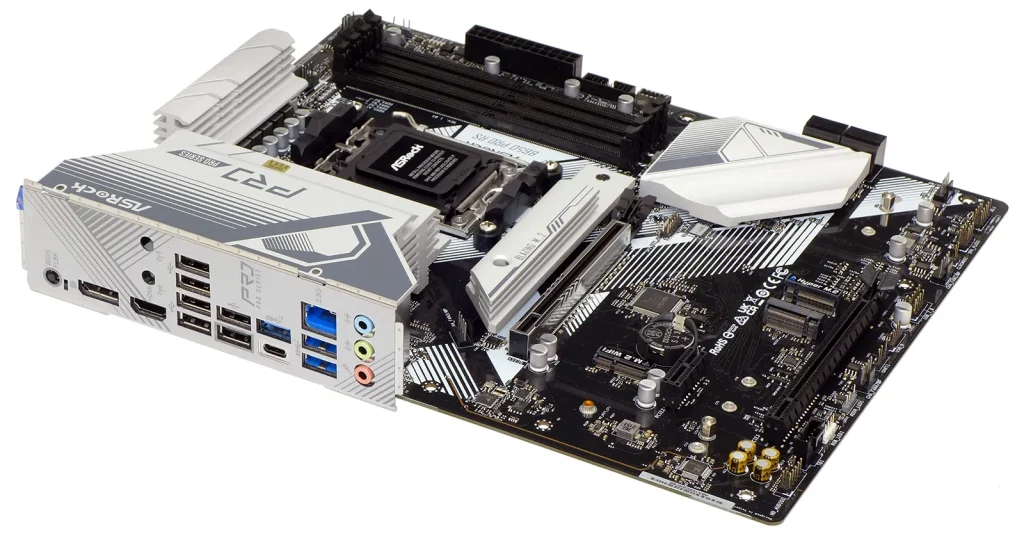
A quick look with the heat sinks on lets us see the two M.2 storage slots above the B650 Pro RS’s bottom card slot, and even those are scaled back to one NVMe 4.0 x4 and one NVMe 3.0 x2 interface. That’s right, one of the NVMe slots is chopped down to half (two lanes) of a half (v3.0) of a half (v4.0) of the current fastest NVMe 5.0 x4 standard. That new standard is present only on the center slot, which is covered in an aluminum heat sink emblazoned “Blazing M.2” between the motherboard’s CPU socket and top PCIe x16 slot.
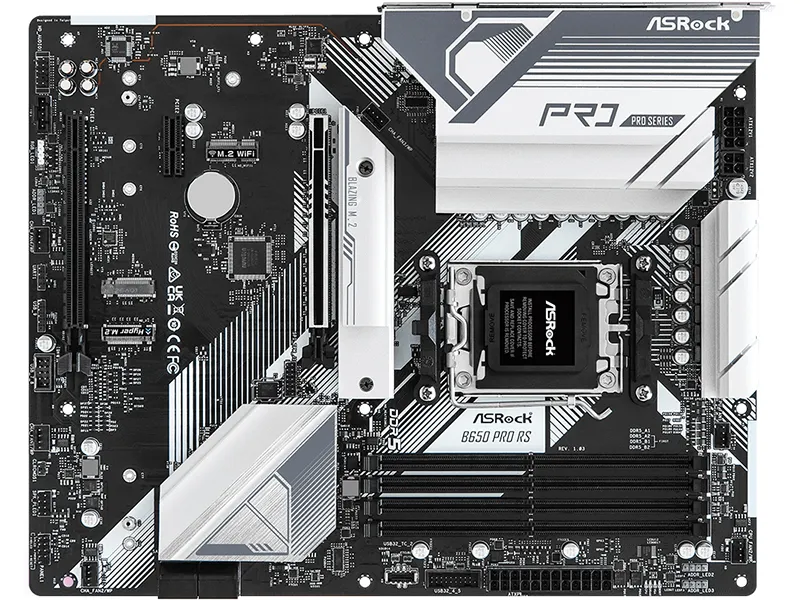
Another slot labeled M.2 WiFi supports Key-E communication cards, as the Pro RS is a bit too cheap to include one even though it has two holes in its I/O panel for the antenna fittings. This is the point where we warn users against trying to upgrade the board, for the simple reasons that most available upgrades won’t include breakout wires for the antennas, the wires included with adapter cards are too short to reach the I/O panel, and the I/O panel holes are flimsy without a support bracket behind them. Having said that, anyone who’d like to pull apart a PCIe x1 WiFi card and place its module into the Key-E slot will probably be able to uses its short cables and included bracket to reach the slot beneath the two-slot plate of their graphics card. And that bit of work will allow them to retain the B650 Pro RS’s PCIe x1 slot, which is open-ended and has no clearance issues for installing cards up to x16 length. Yes, we put some thought into this.
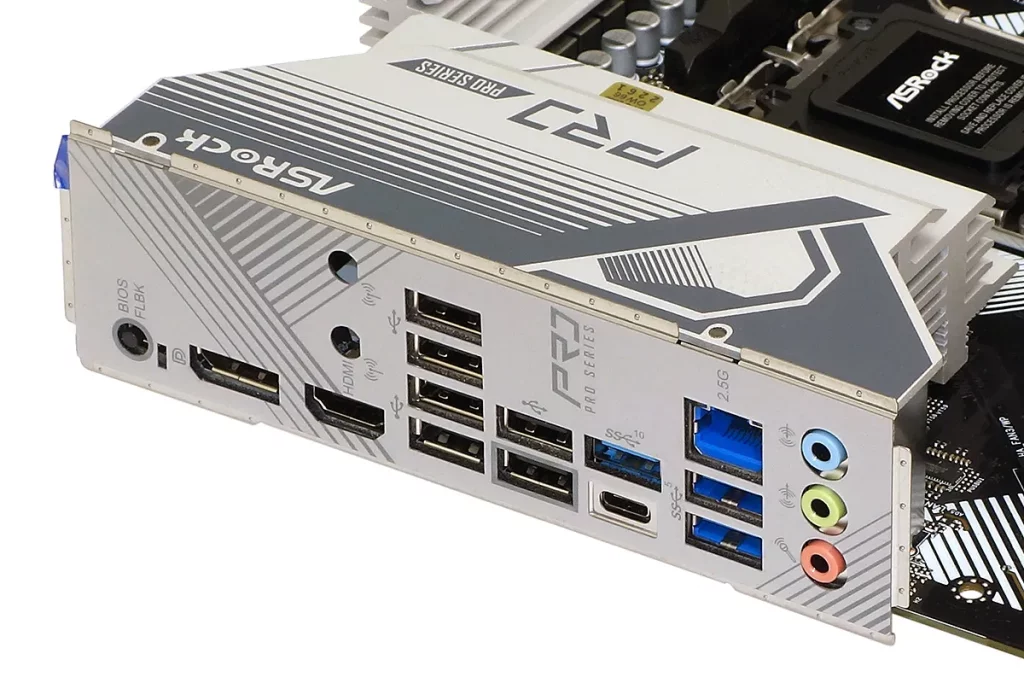
The above description is just an overview, and before we get too far into the layout specifics of internal components we really should cover what’s available to the end user. There’s a USB Bios Flashback button for starters, which allows users to upgrade firmware without a CPU and is extremely useful when pairing a new-generation CPU with a prior-generation motherboard…some time in the future since we’re still within the AM5 socket’s first CPU generation. There are also two graphics ports for the CPU’s onboard graphics, and both are 4k/120Hz capable. Six USB 2.0 ports are handy in an office type environment where users need things like printers and scanners as some unfortunate souls still work with paper. The USB Type-C port is a single link Gen2 (10Gb/s), as is the Type A port, as ASRock reserves Gen2x2 functionality for the internal front-panel header. Two Gen 1 (5Gb/s) ports reside on the same column as the Realtek RTL8125BG 2.5GbE interface, and three analog jacks interface the low-cost ALC897 audio codec. Let’s peel something!

Anyone who feels the urge to open the above image in a new tab to get a larger (zoomable) version is welcomed, but we’ll also had some closer shots below: Even without those details we can see that the seventeen power phases of which sixteen have matching MOSFETs are only fed by a single EPS12V (8-pin) and a single ATX12V (4-pin) power adapter, and yes we did push the limits of those pins The B650 Pro RS’s forward edge includes its 24-pin power connector, a USB 3.2 Gen2x2 (a single dual-link port) and a USB 3.2 Gen1 (dual single-link ports) interface and four forward-facing SATA 6Gb/s ports (two pair) A small chip directly behind two of those SATA ports feeds them via PCIe.

First we zoom on the voltage regulator, which features sixteen of the same ISL99360 60A MOSFETs previously spotted on ASRock’s Z790 LiveMixer but controlled by a slightly different RAA229620 controller for which we can find no specifics…other than that Gigabyte is using these. Since ASRock specifies fourteen of its MOSFETs feed the CPU, that’s up to 840A being delivered by six (of the twelve) power pins with a total capacity of 504W, assuming the connectors are in perfect condition. At least we shouldn’t have any worries about the MOSFETs getting over-drawn.

Zooming out to see the entire upper half, the B650 Pro RS has three PWM fan connectors surrounding the CPU area, two ARGB connectors near the upper front corner, four diagnostic LEDs for boot processes labeled “Boot, VGA, DRAM, CPU”, the two previously-mentioned USB 3.2 front-panel headers and the NVMe 5.0 slot. One of the USB redrivers is visible in front of the I/O panel audio jacks.

The NVMe 5.0 slot is actually in the middle of the board, so it gets included in the lower image as well. This is where we see the metal-reinforced PCIe 4.0 x16 slot, the previously-mentioned M.2 WiFi, the open-ended PCIe 4.0 x1 slot, the two native plus two ASM1061-controlled SATA ports, the previously-mentioned PCIe 3.0 x2 (ouch) and PCIe 4.0 x4 M.2 storage slots, the four-lane PCIe 3.0 expansion slot with its partly-filled x16 connector shell, and a row of headers that include HD (front panel) Audio, Thunderbolt add-in card, legacy RGB, ARGB, PWM fan, UART, a single-port USB 2.0 half-header, a standard (dual-port) USB 2.0 header, another PWM fan, CLR_CMOS jumper, an AT header for legacy beep-code speaker (4-pin) and power LED (3-pin), and an Intel-style front-panel button/LED group.
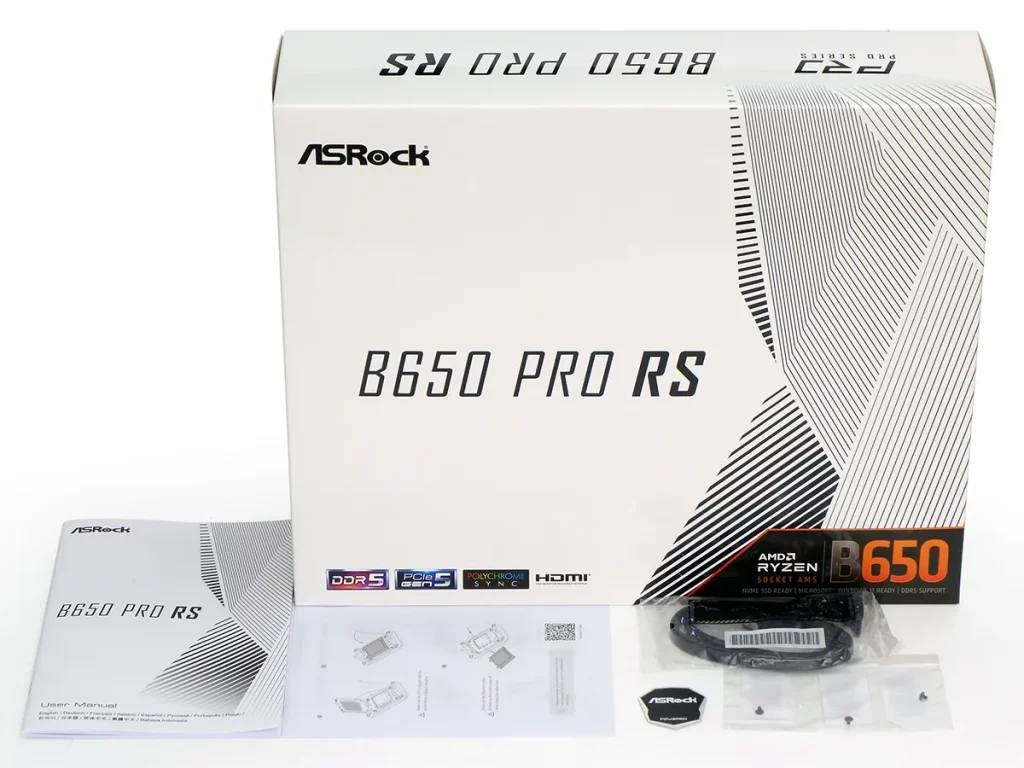
So few people own optical media drives that ASRock feels no need to include a drive disk, but instead includes a downloader in firmware that activates in Windows 10 or Windows 11. We’d prefer to have it on a cheap flash drive, but realize that by the time some of you received the board those drivers and apps would be outdated. A printed manual is included, along with two SATA cables, a case badge, and three M.2 drive screws.

As a reminder, AMD said that feature limits of the motherboard itself would determine whether it was an E (as in B650E) or non-E (B650) model: The same chipset component is used in both motherboard types.
Software
Though the B650 Pro RS includes an auto downloader for drivers in Windows, we had to visit its web page to find its App Shop where additional software is offered. The Live Update page shows which programs are out of date in our installation.


ASRock’s A-Tuning remains a viable option for overclocking, though we found the System Info tab more useful since our overclocking happens in BIOS. The Fan-Tastic Tuning app is also repeated from firmware.




Blazing OC Tuner is a reworking of ASRock A-Tuning that focuses on the automatic overclocks available from hardware. These include PBO and manual power/temperature threshold control.



Firmware
We were amazed to see that the B650 Pro RS completely lacks ASRock’s ‘Easy Mode’ GUI and instead relies on builders not to freak out when confronted by its classic (aka ‘Advanced Mode’) interface.

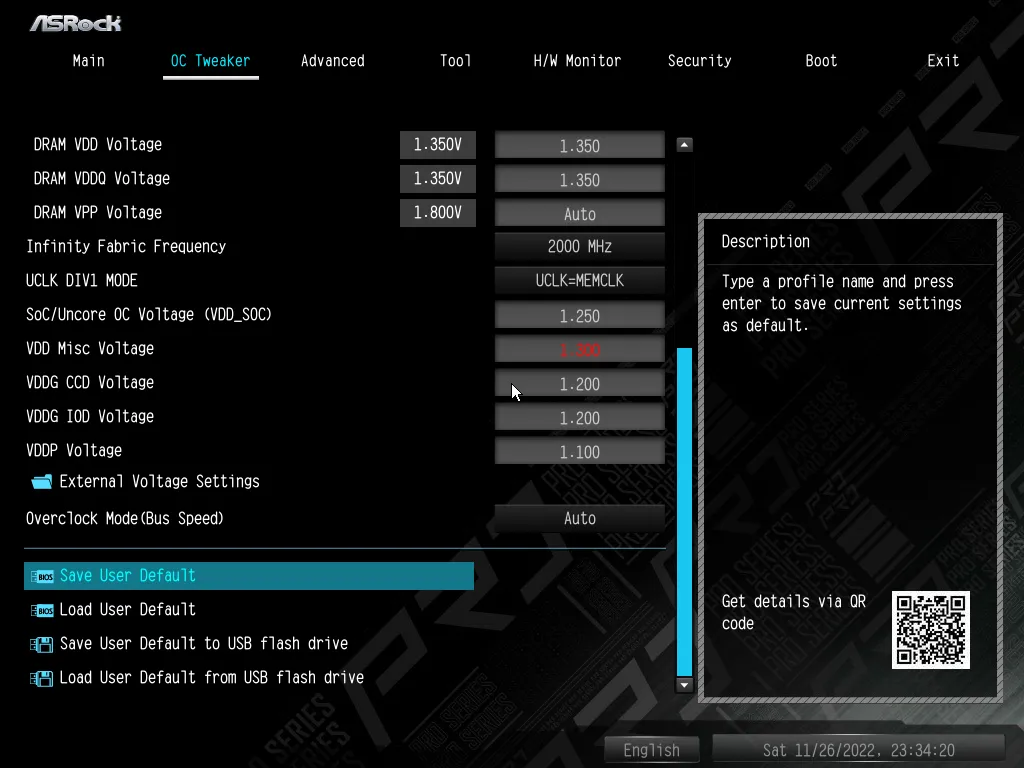


There isn’t a lot to do on the OC Tweaker menu, but there are enough settings to help the uninitiated make the system unbootable. Two popups include a performance preset menu with AMD Performance Boost Overdrive automatic overclocking and storage for up to nine custom firmware configurations as user profiles.


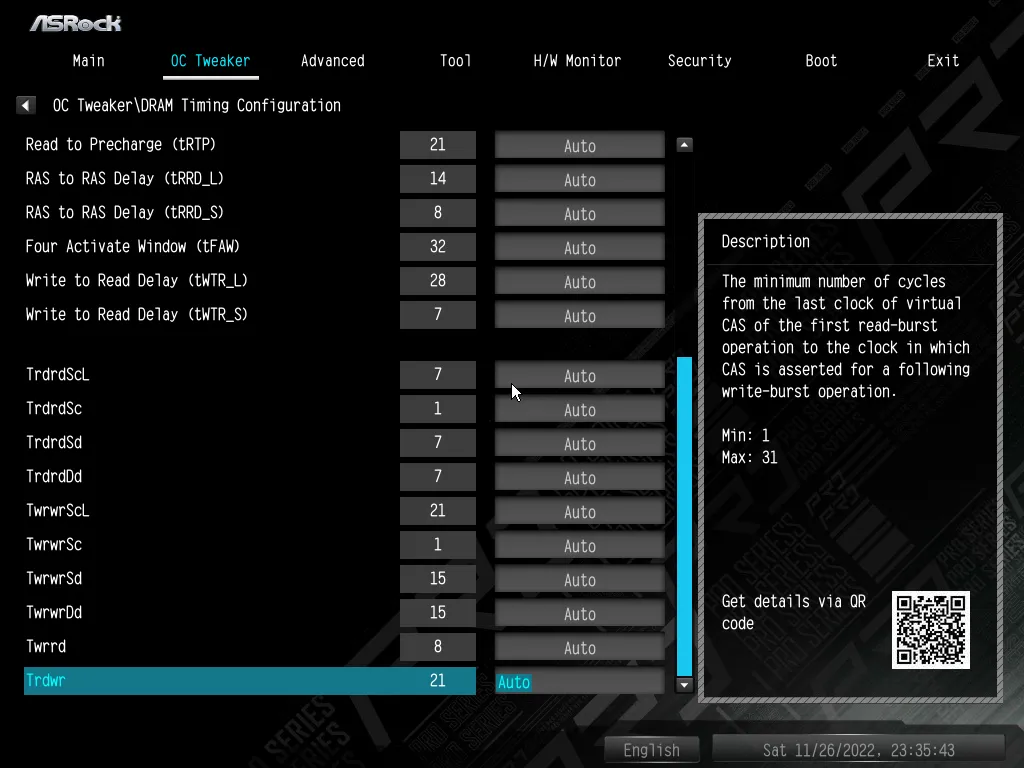

Separate menus enable EXPO or XMP modes and manually adjust timings, since timing adjustments aren’t needed with EXPO or XMP work correctly. We started with EXPO settings and tried 42-cycles for our overclocks.
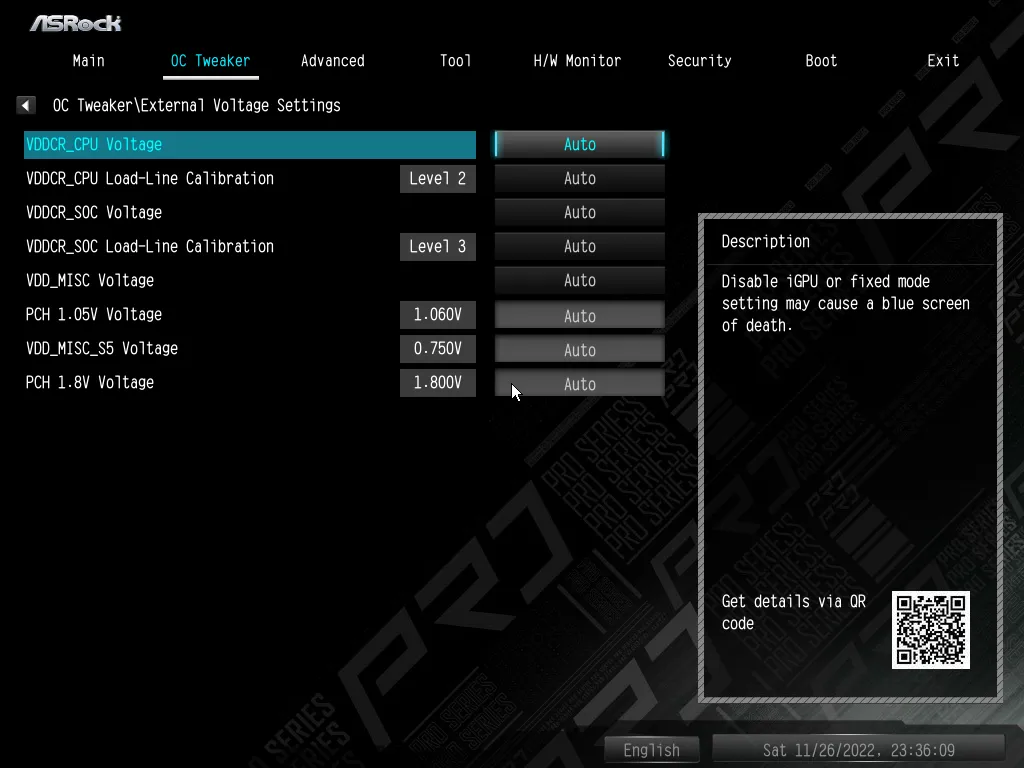
We didn’t really need to enter any advanced control menus to overclock our CPU, as its reaches thermal limits long before any serious efforts take place.



The “Tool” menu includes most of ASRock’s basic tools, except for the firmware downloader which apparently costs too much to implement on a board this cheap. It still has a integrated RGB control for those who would rather not use software to control their lighting.




The H/W Monitor menu begins with a moderate number of readings and moves on to offer individual control for all six fan headers. Fan-Tastic Tuning is a graphical interface for manual fan adjustment, but selecting the Fan Tuning option initiates an algorithm that tests all fans for RPM slope and applies a custom map for each one.
Test Configuration
| Test Hardware | |
| CPU | AMD Ryzen 9 7950X: 16C/32T 4.5-5.7 GHz, 64MB L3 Cache, Socket AM5 |
| CPU Cooler | Alphacool Eisblock XPX CPU, Eisbecher D5 150mm, NexXxoS UT60 X-Flow 240mm |
| DRAM | G.Skill F5-6000J3038F16GX2-TZ5N 2x16GB (32GB) DDR5-6000 CL30-38-38-96 1.35V |
| Graphics Card | Powercolor Red Devil Radeon 6750 XT: 2324-2623MHz GPU, 12GB GDDR6 |
| Power | be quiet! Dark Power Pro 10 850W: ATX12V v2.3, EPS12V, 80 PLUS Platinum |
| Hard Drive | Sabrent Rocket 4 Plus 2TB PCIe 4.0 M.2 SSD |
| Sound | Integrated HD Audio |
| Network | Integrated Wi-Fi |
| Graphics Driver | AMD Adrenalin Edition 2022.10.1 |
We don’t expect anyone to buy a low-cost motherboard to hold their top-model processor, but this is the first time we actually got AMD’s top processor before we began motherboard reviews. We justify our actions by claiming that by passing today’s test, the B650 Pro RS will give budget builders a greater level of confidence in its stability.
Overclocking
And now for the surprise: Prime95 kept producing errors on the B650 Pro RS until we figured out that it was a memory issue. Dropping to DDR5-5600 fixed that issue, but that’s not even the EXPO rating for this DRAM. After trying many things to get our DDR5-6000 kit stable at its EXPO rating, we eventually hit upon the fact that VDDG CCD and IOD voltage were 50mV below SoC and decided to try bringing those up to match. Voila.
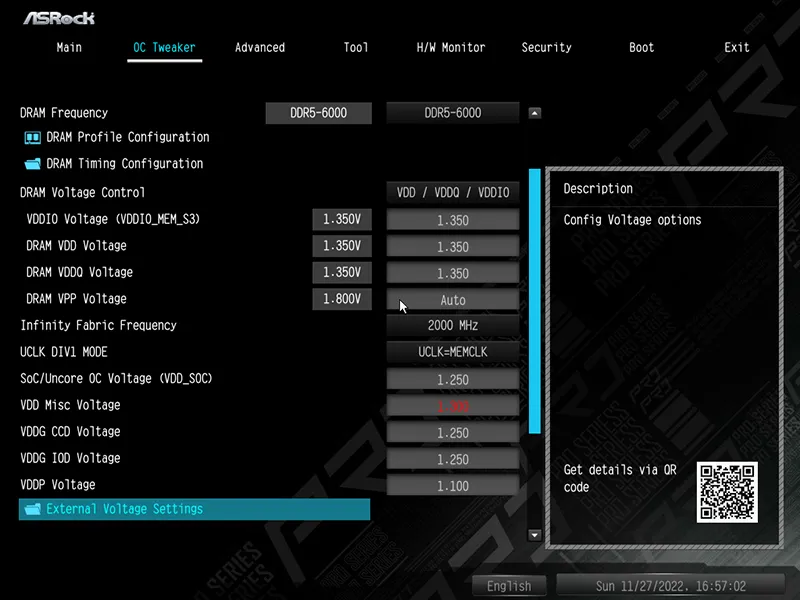
That we needed to do any manual configuration at all is probably a small embarrassment to ASRock, but since this is user-adjustable we’ll go easy on its engineers this time: They’re still makings small adjustments to the default firmware settings for this newish motherboard model.

PBO is overclocking, so we didn’t do anything there. With the two voltage adjustments we just mentioned, the B650 Pro RS was able to reach without crashing (under extended load) the same DDR5-6200 as the X670E Taichi. We were also able to clock the CPU up to 5.4 GHz at 1.32V under Cinebench workloads, and 5.05 GHz at 1.175V under Prime95, before reaching thermal limits for both the CPU cores and the EPS12V/ATX12V power leads at the same time!

We increased the latency to CAS42 in hopes of reaching something higher, but eventually gave up. Looking at the data, it appears that we ran the X670E Taichi’s overclocked memory benchmark at its EXPO timings. Regardless, both kits improved memory bandwidth beyond the stock results shown below.
Benchmark Results
We didn’t see anything peculiar in our memory test set, but the B650 Pro RS did show slightly lower latency at both standard and PBO settings.




The B650 Pro RS also produced slightly higher CPU scores in 3DMark Time Spy, though even the boosted PBO-enhanced CPU score wasn’t enough to give it an overall lead against the X670E Taichi. It even faltered with PBO enabled in 3DMark Storage.

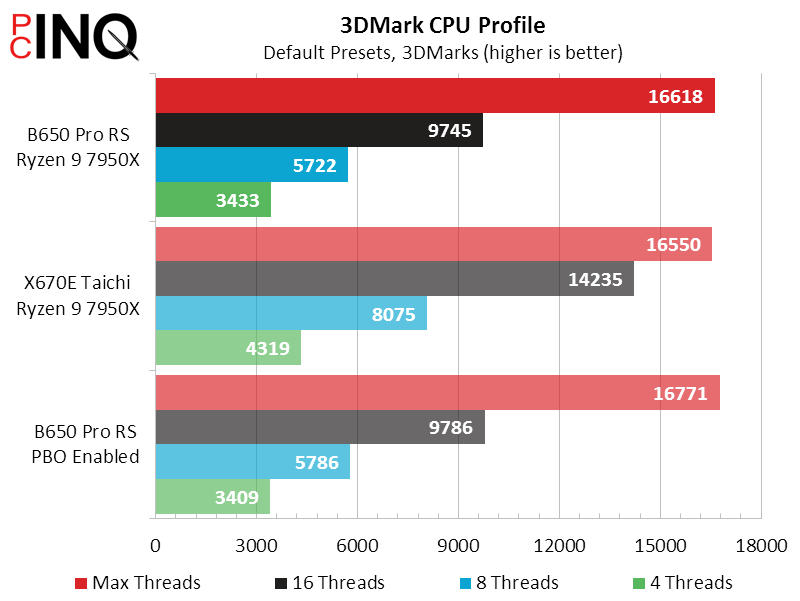


The B650 Pro RS baseline score fell severely in PCMark Productivity, and we couldn’t figure out why through numerous retests. Meanwhile, its PBO score went through the roof in the same suite.




We’re mentioned before that sometimes F1 2021 has hiccups, and by that we mean several consecutive test with unexpectedly low results. We try to exclude those through retesting, but don’t always catch this in a timely manner. They’ll have minimal impact on overall averages.

The X670E Taichi performed slightly better on average in timed tests.




The 7590X consumes a little less power in the B650 Pro RS’s default configuration, and a little more in its PBO configuration, compared to the X670E Taichi. Temperatures were surprisingly higher than the X670E at both default and PBO settings, but energy efficiency favored B650 Pro RS default settings.



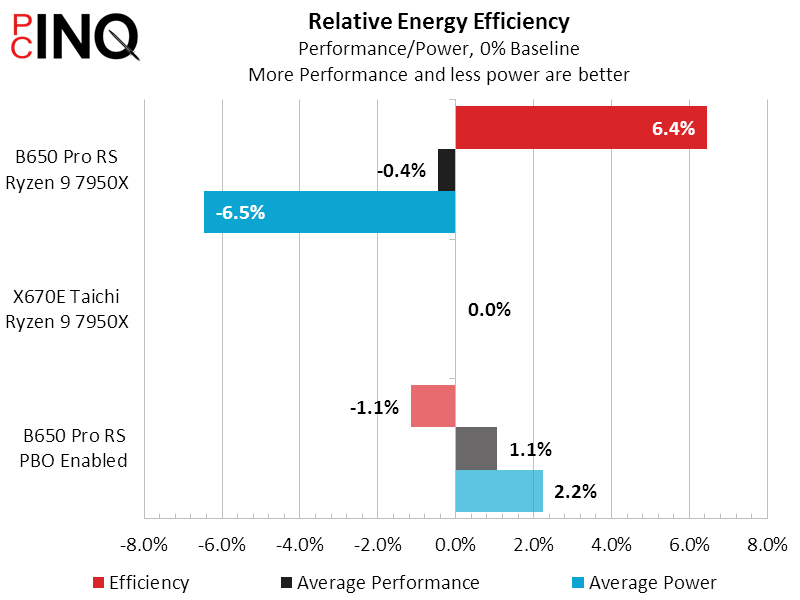
With 1% gained for enabling PBO and only 0.3% lost for choosing a cheaper platform, our bang for the buck chart is really just an inversion of the price difference.
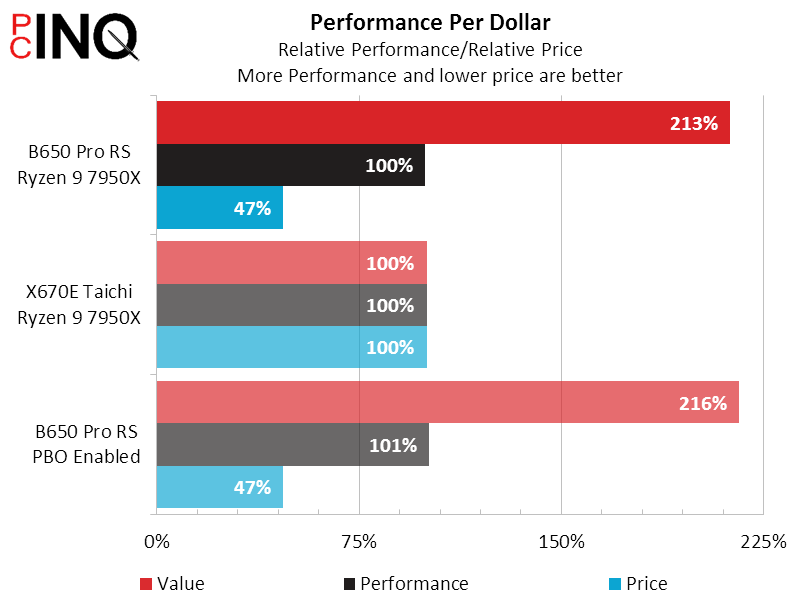
| ASRock B650 Pro RS | |
| Pros | Cons |
|
|
| The Verdict | |
| If you can look past its economizations, the B650 Pro RS will give you a big voltage regulator for CPU prowess and a vast amount of lesser connectivity. | |
To summarize, it’s a bargain.

